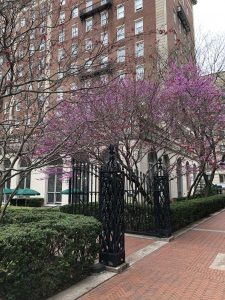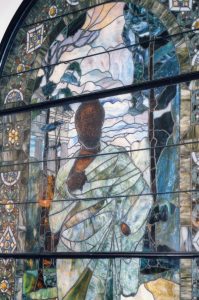Before moving to Morningside Heights in 1897, Columbia spent 40 years on a one-square block campus: from 49th to 50th Street and from Madison Avenue to Fourth (now Park) Avenue. While there are no traces of the old campus in midtown anymore, you can find a few artifacts from Columbia’s previous home that made the trip uptown and are hiding in plain sight on the Morningside Heights campus.
At the University Archives, we recently put together a 49th Street Campus research guide. This guide brings together the sources available to understand Columbia in the second half of the 19th century: administrative records, faculty papers, student coursework and publications, alumni recollections and even images and drawings from Columbia’s home from 1857 to 1897. But tucked away on the present site are a couple of items from that midtown campus.
The Hewitt Gates

In 1857, Columbia moved to what had originally served as the New York Institution for the Instruction of the Deaf and Dumb. The original asylum building was erected in 1829 by the New York architect Martin E. Thomspon. The asylum site had a semicircular driveway with two gates on 49th Street, which presumably were also designed by Thompson.
In time (predictably) Columbia outgrew the asylum’s existing facilities and started to add buildings to the “temporary” site. Students on the old Columbia campus used one of the asylum’s old gates to enter new Hamilton Hall (opened in 1879) just east of Madison Avenue. The other set of gates stood by the new Library and Law School building (1883) near the Fourth Avenue corner. This second set of gates is now on the Morningside Heights campus.
The gates were acquired by Abram Hewitt, Columbia Class of 1842, a Mayor of New York (1887-1888) and a trustee of Columbia, and were taken to Ringwood Manor, his country estate in northern New Jersey. After his father’s death in 1903, Erskine Hewitt gave the manor to New Jersey for use as a state park. In 1938, with Erskine Hewitt’s consent, the Department of Conservation and Development of New Jersey presented the gates to Columbia as a memorial to Abram S. Hewitt. You can now cross these gates, which stand between John Jay Hall and Butler Library.

Sophocles and Vergil

On their Class Day, the Class of 1885 presented the library with a gift of a Tiffany-designed stained glass window depicting the Greek tragedian Sophocles. College Librarian Melvil Dewey hoped that this would be the first of a series of windows featuring literary greats that the graduating classes would give to the Library. Classical and modern authors would be depicted in pairs: from Homer and Sophocles to Shakespeare and Milton. Six years later, the Class of 1891 presented the Library with Roman poet Vergil, but this was the second and last class gift.
After the move to Morningside, the buildings in the old site were demolished and the land was sold. However, the Sophocles and Vergil windows were spared and they were for a time on display at Hartley Hall, the first dorm built in Morningside (1905). They adorned the lobby for about 40 years, and then Sophocles and Vergil were put in storage. Almost 60 years later, the windows were re-discovered by Columbia College Dean Austin Quigley. In 2003, the windows were re-installed in the remodeled lobby of Hamilton Hall, where you can now see them.
